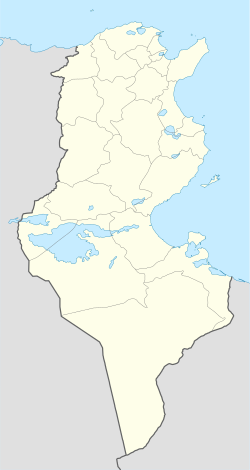From Wikipedia, the free encyclopedia
| Kebili قبلي | |
|---|---|
| Entrance of the Kabili town | |
| Coordinates: 33°42′18″N 08°57′54″ECoordinates: 33°42′18″N 08°57′54″E | |
| Country | Tunisia |
| Governorates | Kebili Governorate |
| Population (2004) | |
| - Total | 18,693 |
| Time zone | CET (UTC+1) |
| - Summer (DST) | CEST (UTC+2) |
Kebili (or Qibilī; Arabic: قبلي) is a desert town in central Tunisia. It is located at around 33°42′7″N 8°58′25″E, south of the Chott el-Jerid. It is the capital of the Kebili Governorate.
Contents[hide] |
[edit]History
Kebili or in correct spelling Gibili is one of the oldest Oasis in Tunisia and North Africa. Kebili holds the earliest hard evidence of human habitation in Tunisia (found near the town) and dates back about 200,000 years. Kebili, as many others Tunisian towns, entered under the control of Roman Empire after the Punic Wars.
[edit]Demographics
The Kebili population is diverse compared to other Tunisian governorates. There are three main race/ethnic groups:
- Arabs: They came to Kebili in early days of Islamic Conquest. Most came from the Southern Arabian Peninsula (known today asSaudi Arabia and Yemen). They still hold the names of their ancestor's tribes.
- Berbers: They are the native inhabitants of Tunisia and North Africa. Berbers are considered minorities because they prefer to live in mountains (the most famous site is Matmata).
- Blacks: They came to the city when it was a famous slavery trade center. See economy for more information.
[edit]Language and Religion
Arabic is the dominant language in the region. The everyday Arabic differs from literal Arabic to varying degrees. The most noticeable difference is in the pronunciation of the letter Qäf; it is pronounced Gä. See also Tunisian Arabic. Islam is the dominant religion. Kebili, as many other Tunisian towns, holds a great number of Soofiat Maqams (Saleheen).
[edit]Economy
The Kebilian economy has seen diverse orientations through its history. Kebili was one the main hubs of the African slavery trade to satisfy European needs at that time. Slaves were taken to Europe through the port of Gabès. Nowadays, Kebili relies heavily on agriculture and tourism.
[edit]Agriculture
The main agricultural product in the region is dates, or deglets. Kebili produce a very high quality date, exported around the world and contributing significantly to the local and national economy.
[edit]Tourism
Beginning with national independence, the government of Tunisia has encouraged tourism projects and resorts in the Saharan region. Of these Douz, south of Kebili, is the most famous Saharian destination of Tunisia (known as the Sahara Gate).



Aucun commentaire:
Enregistrer un commentaire